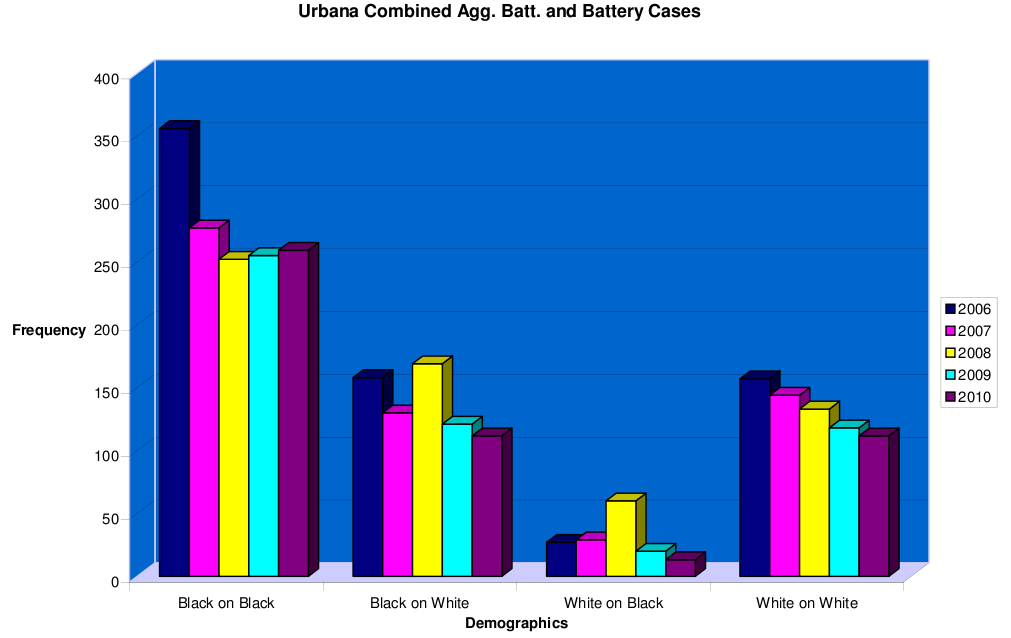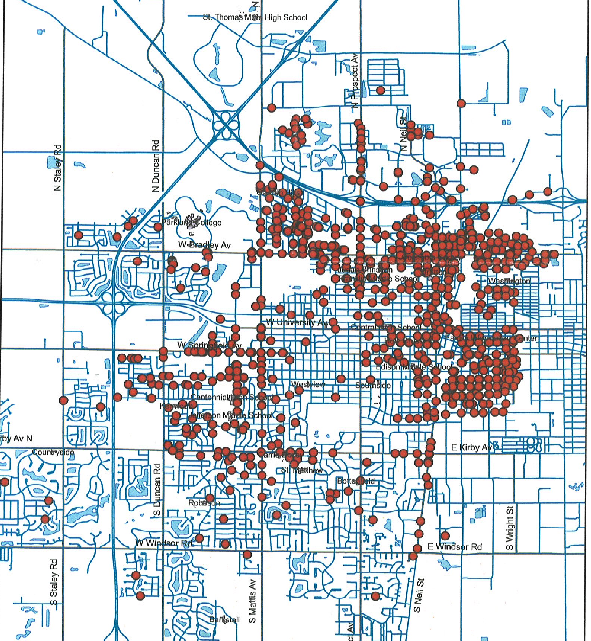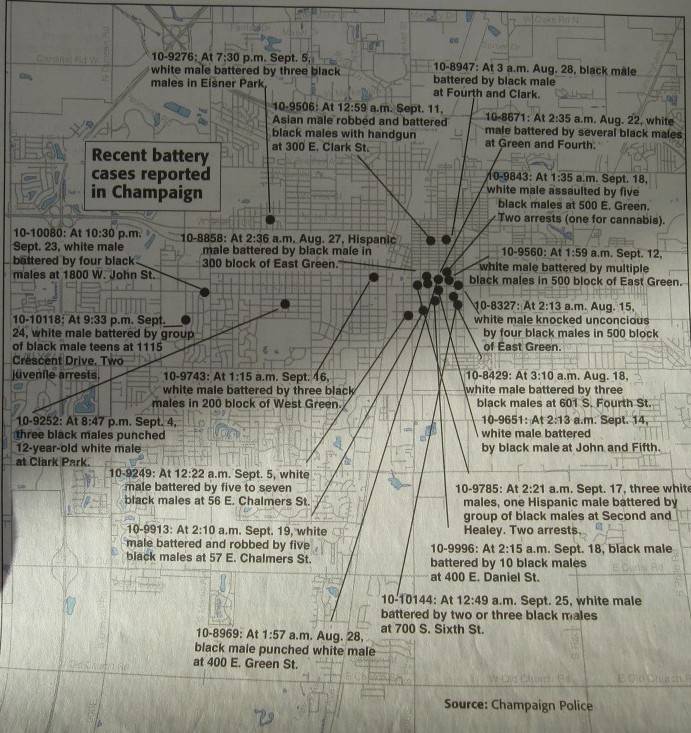“Polar bear hunting” has been scaring the hell out of white Champaign-Urbana for almost two months now. Reports of possibly-coordinated, race-motivated attacks by black males on their caucasian counterparts for purposes of sport have captivated the newspaper-devouring public. What in the world is happening? Have you perhaps been able to avoid the media coverage of these attacks, or need a refresher course? Let’s look at the paper of record:
“POLAR BEAR HUNTING” COVERAGE IN REVIEW
Over the course of four weeks from September 9 to October 6, the News-Gazette ran eight front-page stories regarding black-on-white battery incidents in Campustown and Champaign. Battery cases don’t generally get much coverage in the N-G (I’ll come back to that), but on September 6, a piece entitled “Information sought on aggravated batteries” appeared on page A-4. The Champaign Police Department was looking for information on two attacks in August involving groups of black assailants and white victims, both in Campustown. From then on, battery was front-page news:
- September 9: “Senseless attacks appear to be linked” (titled “Unprovoked attacks appear to be linked” in its online version). Following two bizarre attacks on pre-adolescent boys — one in Eisner Park and one in Clark Park — possible links are drawn to the August attacks in Campustown. CPD Sgt. Jim Rein puts a undeniably catchy name to this phenomenon: “Years ago, I can’t say a specific year, that was part of a local gang (rite) to see if you could knock out someone with one punch. They call it polar bear hunting.” The N-G would later run a retraction regarding the use of the phrase, as Rein intended the phrase to describe events in past years and not necessarily describing these attacks in those words, but you can’t put a genie back in the bottle, as they say.
- September 18: “Two Charged in attack on UI Campus,” regarding arrests for a separate Campustown battery incident that occurred on September 17.
- September 20: “Police chief to suspects: we’ll put an end to this,” noting that two Urbana men had been arrested for aggravated battery and hate crime. CPD Chief R.T. Finney is quoted as saying, “We are familiar with what they’re doing and how they’re operating and we’re beginning to turn the tables on them. We’re basically hunting them.” State’s Attorney Julia Rietz: “The most appropriate charge for them was aggravated battery and not hate crime. That’s because aggravated battery on a public way is a more serious offense than hate crime and hate crime is harder to prove.”
- September 29: “The epitome of cowardice” (or “Former TV weatherman victim of unprovoked attack” if you’re reading online), as Mike Sola was beaten following a Centennial football game, featuring this item: “(Earlier reports indicated a slang term of “polar bear hunting” for these attacks, but police officials say that term is not evident in the recent attacks.)”
- October 2, 5 and 6: Arrests made of several teens for their role in the aggravated battery of Mr. Sola.
 October 3: “Embarrassing to our community” (or “No evidence of coordination in series of attacks” online), featuring statements from local black business owner Seon Williams condemning the attacks. The article included a map (right, click here to embiggen), provided by the CPD, showing locations of “recent battery cases reported in Champaign.” The article features this statement: “Since Aug. 15, there have been 20 attacks on white males, mostly in the campus area, committed mostly by groups of young black men.”
October 3: “Embarrassing to our community” (or “No evidence of coordination in series of attacks” online), featuring statements from local black business owner Seon Williams condemning the attacks. The article included a map (right, click here to embiggen), provided by the CPD, showing locations of “recent battery cases reported in Champaign.” The article features this statement: “Since Aug. 15, there have been 20 attacks on white males, mostly in the campus area, committed mostly by groups of young black men.”
An editorial, published the following day, October 4, in the N-G, titled “It’s obvious what assaults are about,” repeats the assertion that “All the victims have been white males and all but one of the attackers have been black males. (One was a Hispanic male).” Also in the editorial, it’s noted that “[the phrase ‘polar bear hunting’] … was resurrected by the news media when the recent series of attacks started to show an undeniable pattern.” If you’re the news media outlet that did the resurrecting, it takes a certain lack of self-awareness to blame “the news media” writ large for that.
Some questions at this point:
- Holy cow, is that true? All of the battery cases reported in Champaign between August 15 and October 4 were perpetrated by black males on white males, except one in which the attacker was hispanic?
- 20 attacks in a period of about six weeks in Champaign sounds like a lot, especially since I’ve been told about several of them in breathless front-page newspaper accounts emphasizing their racial component. But how does that look in context? How many cases of battery and aggravated battery would be expected during that time period, and what is the usual demographic distribution?
- These incidents being reported are all in Champaign. Why doesn’t Urbana have similar problems?
- I’ve heard that the north end of Champaign has problems with crime (in fact, I seem to recall reading about many of those crimes in the N-G on a daily basis), but according to that map, it’s the safest part of town, with nary a battery case to be found. Have my thoughtless perceptions been couched in racial prejudice?
A CLOSER LOOK AT THE MAP
The first question is pretty easy to answer. If you look more closely at the map above, you’ll see that two of the incidents involve victims who are black males, one is an asian male, and there’s an additional hispanic male in a group with three white males who were victimized (the only incident noted as involving multiple victims). Also, the way it was phrased in the editorial made it sound like one of the attackers was a hispanic male, when in fact one of the victims of an individual attack was, and none of the attackers were. Additionally, a subsequent N-G report noted that the victim of the September 12 battery on the 500 block of E. Green was of Polynesian descent, whereas he’s described as a white male on the map.
So, that’s actually only 14 out of the 20 incidents that are “attacks on white males.” It’s possible that a 100% correlation in a tiny sample size could imply causation, but 70% — especially in a community that is 73.2% white — doesn’t mean much of anything.
The N-G editorial board, Mary Schenk, and whomever her editor is can be given a pass for not being aware of the one victim who was Polynesian. However, missing the other five victims of color is due to either miserable reading comprehension or an over-enthusiastic desire to keep riding the narrative that they’d been presenting to the public. Or perhaps a mixture of the two.
DIGGING INTO THE NUMBERS
In order to answer the rest of the questions, we engaged the Champaign Police Department for more information. Chief Finney, in an email from October 15 in which he’d discussed sending us the updated battery map, said, “I could also send you the various demographics of specific crime codes for 2009. Those would be separated by crime, IE: Robbery, Agg. Battery, etc… It is a hand count so it breaks down only by white, African American, Asian, Hispanic.”
Gary Spear, CPD Crime Analyst, provided us an updated map of battery cases in Champaign (download the pdf here) on October 19. This map included five subsequent incidents in addition to the 20 on the map published in the N-G. They were: a “sexual orientation related” battery of a white male by two unknown-race males at 6th and Green; two white female victims battered by three black females at the Clybourne; an attempted robbery of a white male by two males, one black and one unknown, at 6th and Healey; a black female victim battered and had her clothes stolen by three black males at 100 S. Country Fair; and a victim of unspecified race battered by four black males in the lot behind the Highdive in downtown Champaign.
Spear also provided a list of numbers of crimes by type in Champaign for 2009 and 2010 on October 20. For instance, there were 347 cases of aggravated battery and 217 cases of battery in Champaign in 2009, for a total of 564 (an average of 47 per month). In the first nine months of 2010, there have been an average of 47 batteries and aggravated batteries per month. (Please note that at this rate, it would be expected for there to be about 66 incidents of battery and aggravated battery in the time period (42 days) covered by the map which appeared in the N-G.)
These items were helpful, but didn’t provide the location or demographic information to put the recent attacks into context, and the CPD stalled and finally balked at providing additional statistics. So, we filed a Freedom of Information Act request with both the City of Champaign and the City of Urbana for location and demographics of assailant(s) and victim(s) for all batteries and aggravated batteries for 2006 through 2010.
Urbana supplied the information requested in a timely manner, producing a 138-page printout, and even the data in spreadsheet form upon additional request. The results were eye-opening and very consistent from year to year:
- Urbana experiences slightly more batteries and aggravated batteries than Champaign (an average of 652.6 per year from 2006 to 2010)
- Demographically, the incidents break down as follows: black on black: 280 per year on average; white on white: 133 per year; black on white: 138 per year; white on black: 30 per year; and other combinations or unknown assailants account for the balance (71 per year) of the incidents.
- Phrasing it differently: blacks commit three-fourths of batteries in Urbana, but a white person is just as likely to get battered by a white person as they are a black person, and the number of blacks who are victims of battery is roughly equal to the number of whites. Download a pdf of the chart shown below here.
- The variation from year to year was pretty small, but 2008 notably had increased rates of both black on white (169) and white on black (60) incidents. Download a pdf of the data summary here.

I did not map out the Urbana incidents because of time constraints and lack of ambition, although location information was supplied. If anyone wants to take a crack at it, shoot me an email and I’ll send you the spreadsheet. (UPDATE — 11/17/10: Thanks to Tim Green, there are now more maps of this data available than you could ever want.)
Meanwhile, I’d received no response to the Champaign FOIA after a week, and I stopped by the police station last Wednesday to check on it. The records department supplied two pages with maps, one for 2007-2010 cases and one for 2005-2010 cases. You can download both maps here, and the 2005-2010 map is shown below.

I was told by records desk personnel that it was against CPD protocol to supply demographic data for crimes. When I told them that Urbana had supplied the data, I was politely told that I was not in Urbana. An email request to Rene Dunn of the CPD for an explanation for the denial of this portion of the FOIA request — as well as an explanation for the reasoning behind supplying demographic data for crimes on the battery map but not for the bulk of them — was not returned.
Because of the huge number of data points displayed on this map, it’s difficult to get an exact count for how many battery and aggravated battery incidents occur in each part of town, but it’s clear that the north end and Campustown see most of the cases. It’s very unusual that there were no incidents north of Church Street on the battery map printed in the N-G (nor on the updated map supplied to us).
Combined with the low number of incidents catalogued on the “recent battery cases” map (compared with the number of batteries and aggravated batteries expected for that time period), the possibility exists that data was selected for public consumption which fits a particular narrative. I also asked the CPD about this discrepancy in the same email, which was not returned, about the FOIA denial.
MORE RECENT EVENTS
 For what it’s worth, there have been at least four incidents of battery or assault involving caucasian assailants in Campustown reported in the N-G in the past two weeks.
For what it’s worth, there have been at least four incidents of battery or assault involving caucasian assailants in Campustown reported in the N-G in the past two weeks.
At right is Christopher Thamm, arrested in the parking deck beating linked above. The newspaper report didn’t identify his race, but I figured it was worth the trouble to file a FOIA request for his mugshot.
I would really like to begin referring to white-on-white violence as “cracker jacking.” I think that it’s at least as catchy as “polar bear hunting,” and more descriptive. Who’s with me?
Also, on October 27, a white Urbana teen was beaten by a black teen who told him, “It’s because you’re white.”
IN CONCLUSION
There is a lot of racial tension in our community for reasons both recent and historical; that much is undeniable. There’s also a clear problem with battery and aggravated battery: there were 691 aggravated batteries in Champaign and Urbana in 2009, and compared to Bureau of Justice statistics for 2008 in Illinois, a community with a population of 112,616 (according to the most recent census figures) should expect to have 341. These are serious crimes which need to be taken seriously, and the frequency with which they occur (three batteries and aggravated batteries, every day of the year, on average) is a real problem.
However, there’s a reason you don’t read front-page stories about each of these three incidents every day: most (about 80%, if Urbana demographic data can be extrapolated to Champaign) don’t fit an inflammatory narrative of black-on-white. Media-driven hysteria which assigns a storyline to statistically-insignificant small sample sizes, cherry-picked data, and attempts to assign motivation and connection to crimes which are ultimately appear to be unrelated (except in their demographic makeup), is an extremely unhealthy way to approach these issues.









